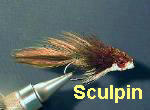
When the waters are high and off color as they are now in the Southeast as well as other parts of the country, it is time to go to the trusty old streamers. Many anglers are reluctant to use streamers because they lack the visual appeal of dry flies, and they lack the delicate touch of a nymph. But streamers are effective for a variety of reasons.
In high water conditions the trout especially big brown trout go on a feeding frenzy gobbling up small minnows, sculpins, crayfish etc. A streamer need not be fished delicately and it does not need to match the speed of the current. Indeed, if it goes faster than the current, it appears to the trout as a bait fish suddenly realizing that it is in grave danger and this will prompt a fast strike.
The accepted method of fishing a streamer is quartering casts up and across the stream and then, with the line tight, stripping the line in short, sudden bursts, as it is carried downstream by the current. Expect the strike to come when the line begins to straighten out downstream from where the angler is standing. What occurs is that the line reaches the end of the drift and the leader starts to straighten out. The streamer then lifts toward the surface. This is the action that triggers a strike from the trout that must imagine that the bait fish is trying valiantly to escapes.
There is no special way to work a streamer. However, short rapid bursts will replicate the backward swimming of a crayfish or a sculpin as they seek to escape; the slow finger-twists will move the streamer just enough to cause its hackle to flare outward with each pause resembling the gill action of a minnow as it breathes.
Remember also that the colder temperatures will cause the trout’s metabolism to slow down and they will be somewhat lethargic moving slowly so work the streamer slowly.
Excerpts have been taken form Jim Casada new book Fly Fishing in the Great Smoky Mountains National Park: An Insider’s Guide to a Pursuit of Passion





